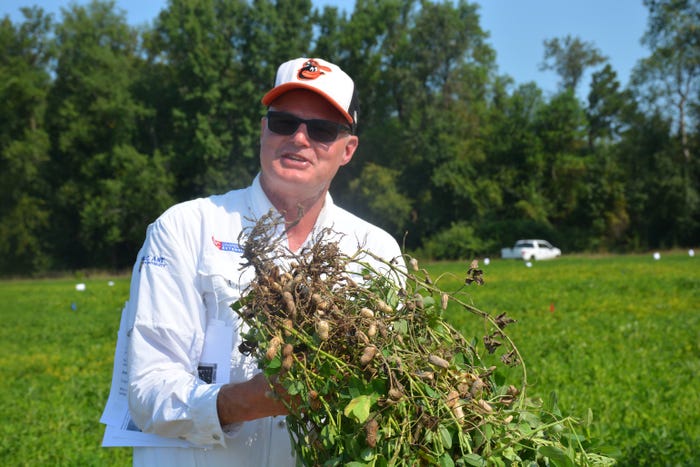
The Virginia-type peanut variety Bailey became a rock star when it was released by North Carolina State University’s breeding program in 2008 because it offered both great yield potential and excellent disease resistance. Soon, it became the No. 1 variety grown across Virginia and the Carolinas.
In 2017, Tom Isleib’s breeding program at North Carolina State released Bailey II, a high-oleic version of Bailey with a slight yield advantage over Bailey as well as excellent disease resistance. Today, Bailey II is the most popular Virginia-type cultivar grown by farmers in the Carolinas and Virginia.
Both Bailey and Bailey II are highly resistant to early-season leaf spot. The challenge today is that late leaf spot has become more prevalent over the past five years and while Bailey and Bailey II are resistant to early leaf spot, they are susceptible to late leaf spot.
With this challenge in mind, Jeff Dunne, who took over peanut breeding duties at North Carolina State, upon Tom Isleib’s retirement in 2018, is working on a new version of Bailey II that will offer resistance to late season leaf spot.
Speaking at the Southeastern North Carolina Peanut Field Day Sept. 14 at the Border Belt Tobacco Research Station in Whiteville, Dunne said Bailey and Bailey II were likely highly resistant to early leaf spot, but not late leaf spot. Because early leaf spot was more prevalent during the development of Bailey, it wasn’t known it was susceptible to late leaf spot.
Wild species
Dunne explained that in the development of Bailey, Islelib worked with fellow peanut scientist Tom Stalker at North Carolina State who is known worldwide for his work in using genetic material from wild peanuts to diversify and improve cultivated species. Isleib and Stalker worked together to identify resistance to leaf spot and Bailey was developed with material from wild species lines.
“We circled back to the original material used in our crossing program. We realized there was one very important gene that didn’t make its way into Bailey. We’ve identified this material in collaboration with a group at the University of Georgia that also works on wild species. This summer is the first time we’ve started making crosses with this material to work that gene into the background of Bailey II,” Dunne said.
This material is being crossed into the background of Bailey II to offer both early leaf spot resistance as well as late leaf spot resistance. Like Bailey and Bailey II, Dunne said this third version of Bailey will be resistant to tomato spotted wilt virus and will be high oleic and offer excellent yield potential.
“Foundation and certified seed will be available in three years once the line is developed. We just started crossing and there will be several years of testing before anything gets released. Chances are this will take about eight years total before we send any released seed to North Carolina foundation seed producers,” Dunne explained.
NC 20
Also, at the field day, Dunne highlighted NC 20, a new line his program is working on that is similar to Bailey II, but offers a slightly larger seed in comparison to Bailey II. Like Bailey II, it is a high oleic, offers excellent disease resistance and strong yield potential. “NC 20 is able to hold onto it pods even under heavy disease pressure,” Dunne said.
One difference between NC 20 and Bailey II is that NC 20 is a later maturing line. It matures seven to 14 days after Bailey and Bailey II. Dunne says this will allow farmers to stagger their harvest dates.
“You can leave NC 20 in the field a little bit longer. As you leave it in the field to mature, you’re still getting that yield, but you are also recovering a better grade,” Dunne said.
“The later you dig NC 20 the better. It also holds its yield under late leaf spot if you are worried about late season leaf spot pressure,” Dunne said.
Dunne said foundation seed of NC 20 should be available in 2024.
Later maturing varieties
In the meantime, North Carolina State University Extension Peanut Specialist David Jordan says farmers would welcome a later maturing variety so they could better stagger their harvest dates. He says he always explains to new peanut growers that they can plant a lot more acreage than they can pick in a timely manner.
“In terms of maturity, we would like to have some varieties with a little spread. We definitely don’t have that with Bailey II, Emery or Sullivan. If you plant these varieties on the same day, they are going to mature at about the same time,” Jordan said.
“In North Carolina, if you plant in early-May versus late-May, generally speaking, that’s going to be a seven to 10-day difference at the most in terms of maturity. We really get squeezed from a harvest standpoint, because our varieties don’t spread it out for us very much and our planting dates don’t spread out that maturity very much either,” he said.
“When they get ready, pretty much everything is ready. There is a limited amount of time before things start to shed off. This sometimes forces us to dig peanuts a week early. There is a 5% to 7% loss in yield if we dig a week early,” Jordan explained.
“It’s critical that farmers get their digging and harvesting capacity in line with acreage. And sometimes the bottleneck revolves around turning around trailers. It gets complicated and stressful for a period of time in the fall when it all comes together.”

About the Author(s)
You May Also Like






